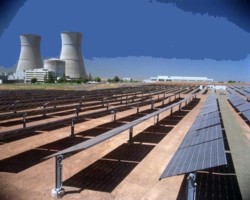|
Renewable
Energy
 There
can be no doubt that the development of non-polluting
renewable sources of electrical energy is the most urgent
priority facing mankind. There
can be no doubt that the development of non-polluting
renewable sources of electrical energy is the most urgent
priority facing mankind.
The
price of oil in 2004 reached the highest levels ever
recorded, far exceeding those of the energy crises of
the 1970s. In March 2005, we wrote "if $55 a barrel
is possible today, prices could reach $100 a barrel
in a few years - as consumption by China and India continues
to grow. China is now the second largest importer of
oil and growing. 2004 has seen several surprise downward
revisions in estimated oil reserves by the oil companies."
Oil
is now (September 2005) at $70 per barrel.
It
is increasingly being predicted by oil industry insiders
that 2007 will
be the crunch year when consumption exceeds available
production for the first time. The new oilfields that
are needed to bridge this gap do not exist.
Where
will the energy come from to sustain civilisation?
Sources
of Renewable Energy
The
main source of renewable electricity today is overwhelmingly
conventional large scale hydroelectric power. While
wind, wave, solar and geothermal power are the widely
recognised face of Renewable Energy, conventional hydroelectric
still accounts for over 70% of renewable electricity.
However, much of the world's potential hydroelectric
capability has already been exploited and the environmental
consequences of further developments are too serious
for contemplation (damming of rivers, flooding of land).
There is no doubt
that natural energy sources can potentially provide
vast quantities of electrical power that could provide
developed world power levels for the entire world.
The
two main renewable energy systems that are being progressed
by the rapidly growing renewable energy industry are
Wind and Solar power.
Solar Power
is expensive and the best solar cells today convert
only 20% of the energy of the light into electricity.
The
other major drawback of solar power is that it only
operates during the day and most effectively in southerly
latitudes. The large scale battery storage required
is also very expensive.
Wind
Power is relatively inexpensive, reliable and robust.
However, even in the windiest locations wind turbines
only produce electricity 50% of the time. Locations
where enough wind exists to make it worthwhile are also
somewhat limited.
Another
widely available source of renewable electricity exists
which has been overlooked since the 1920s: Atmospheric
Electricity. It is in this area that Meridain
International is carrying out an extensive research
programme.
Energy Efficiency
Between
half and two thirds (50% - 66%) of the electricity generated
by central electricity generating stations in the USA
is wasted in power line transmission losses. (Source:
"National Energy Security Post 9/11", US Energy
Association, June 2002, P34).
If
these losses could be significantly reduced or eliminated,
it would double or triple the effective electricity
generating capacity of the western world.
The
technology to achieve practically lossless electricity
transmission exists. Pulsed high voltage DC transmission
is one of the most promising approaches being re-investigated.
It was first proposed in the 1920s. High voltage high
frequency AC is another viable approach, recently re-pioneered
by the Russian scientist Avramenko.
Motive Power
The
single biggest use of oil today is for transport:
60% of the oil imported by the USA is used for transportation.
In the road transport field, half of the oil burned
in the USA by road transport is consumed by HGVs, SUVs
and Vans - all the least aerodynamically efficient vehicles.
The average fuel efficiency of an automobile in the
USA is no better than the Model T Ford.
This
lack of efficiency is not for want of the availability
of technological solutions. In fact, the USA is
going backwards, as evidenced by the watering down of
the famous 1990 CARB rulings. These ruled that
by 1998 2% of all new cars sold in California were to
be Zero Emission Vehicles and that by 2003 10% per year
of all new cars sold were to be ZEVs.
The
only type of vehicle that meets the ZEV criteria is
a Battery Electric Vehicle.
In
fact, in 2003 no electric vehicles were sold
by the major car manufacturers in California.
Ford, General Motors and the other manufacturers only
ever gave minimal marketing to their programs and terminated
production between 2000 and 2003 citing lack of demand,
in fact caused by absence of marketing and high pricing.
Analysis
of the 7 EV models on the market between 1996 and 2002
shows that their average monthly lease cost was 70%
higher than the equivalent petrol vehicle.
The
Ford Ranger EV was initially priced at $450 per month
compared to $200 per month for the petrol version.
The
only Lithium Ion car available, the Nissan Altra, was
priced at $600 per month.
Not
surprisngly, these high prices more than offset the
lower operating costs of the EV and gave owners no compensatory
trade off for the lower range.
In
late 2004, Ford and General Motors were engaged in a
program to crush nearly 3000 serviceable nearly new
electric vehicles rather than allow their lessess to
keep them. A grassroots campaign "Dontcrush.org"
succeeded in saving some of the vehicles during 2005.
The
only perceived drawback of battery electric vehicles
is their lower range compared with petrol vehicles,
despite the average trip length that the motor car is
used for being less than 20 miles. But with the
latest lithium ion batteries, prototype EVs are now
being produced with a range of 200 miles or more.
|
